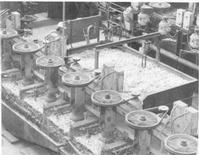


Chapter 10
I 1. Introduction
II 2. The Role Of Technology
III 3. Some Highlights Of Australian Minerals Technology
i Gold
ii Copper
iii Lead-zinc-silver
iv Technology in iron ore mining
v Iron and steel technology
vi Nickel
vii Mineral sands
viii Bauxite, alumina, aluminium
IV 4. Other Technological Achievements (in brief)
V 5. Export Of Technology
VI 6. Education And Research
VII 7. The Scientific Societies
VIII 8. Conclusion
References
Index
Search
Help
Contact us

To be specific about the concentration practices in the three currently producing mines, the grades of concentrates and recoveries are probably the highest in the world, for example, lead concentrates of 76 per cent Pb containing 97 per cent of the lead and 94 per cent of the silver, and zinc concentrates (marmatite) of 53 per cent Zn containing 90 per cent of the zinc. Factors favouring these outstanding grades and recoveries are, of course, the coarse grained texture, the high grades of the mill feed and the low content of iron sulphides. By contrast the other major producers. Mount Isa and Read-Rosebery, are fine grained, lower in grade and heavy in iron sulphides, and these and several smaller producers have the additional feature of economic contents of copper which complicate the mill circuits and require much more involved reagent additions than the very simple Broken Hill combination. It should be noted, however, that the flotation practice of these smaller producers, which includes production of separate copper concentrates in the manner pioneered at Lake George in the 1940s, has proved to be of special interest to Japanese metallurgists in the development of the Kuroko ores.
Major refinements of the concentrating practice in Broken Hill have been effected over the past 20 years by extensive use of computer controls and by the installation of on-stream analysis in the mill slurries using radioisotope probes developed in collaboration with the Australian Atomic Energy Commission. Broken Hill pioneered the process with the world's first installation in a mineral concentrator in 1968. Other collaborating bodies were Australian Mineral Industries Research Association and Australian Mineral Development Laboratories, and the latter took over in 1977 the manufacturing and marketing of the probes. By 1986 there were 33 installations around the world of the AMDEL on-stream analysis system, which has been extended to such applications as on-line analysis of iron ore and coal on conveyor belts and of coal slurries.
At an intermediate stage in its history, when confirmation of the extent of the ore reserves at the northern and southern ends of the lode promised an extended life for the mines and the city, a number of steps were taken to consolidate the situation. The Central Power Station was established in 1931 to supply electric power and compressed air to all mines, thus eliminating the several individual installations. The concentration plants of the North, South and Zinc Corporation were substantially rebuilt. An extensive rehabilitation of the mine leases and housing areas and of the overstocked pastoral environment was undertaken on a continuing basis and this, combined with a permanent water supply, converted the environment and the living conditions in a most substantial way. After its first 100 years of mining Broken Hill has an added role as a civic and cultural and tourist centre with important medical services for the inland, a school of artists and some 25 art galleries.

Organisations in Australian Science at Work - Australian Atomic Energy Commission; Australian Mineral Development Laboratories; Australian Mineral Industries Research Association
People in Bright Sparcs - Blainey, G.
 |
Australian Academy of Technological Sciences and Engineering |  |
© 1988 Print Edition page 747, Online Edition 2000
Published by Australian Science and Technology Heritage Centre, using the Web Academic Resource Publisher
http://www.austehc.unimelb.edu.au/tia/713.html